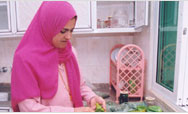You are here » Home » Telling Our Story
Case Study
Winter no longer barrier for farmers to produce and sell year-round
Incomes Grow as Farmers Warm to Greenhouses

Photo: Catholic Relief Services
In Herat Province, farmer Mola Shah Gool earned $660 from his greenhouse during the
winter, a time period when he normally has no income
“I plan to build more green-houses,” says farmer Mola Shah Gool. “For a small cost, I can gain a good income, and they are easy to water from shallow wells, common in this dry area.”
Challenge
Most farmers in Afghanistan make little or no income during the winter. In addition, the high start-up costs for cold storage that could boost farmer income is not feasible for the average small-to-medium scale farmer. In Herat Province, the approximately 1.5 million inhabitants rely on fresh fruit and vegetables imported from Iran or Pakistan at high prices during the winter. Afghan farmers do not possess the greenhouse technology necessary to grow late-season or off-season fruits and vegetables to meet this large demand.
Initiative
A USAID-funded initiative worked to promote a greenhouse technology demonstration project in Herat Province. Greenhouse cultivation has four distinct strategic advantages: off-season income, import substitution, low start-up costs, and sustainability. Greenhouses provide income to farmers during the winter months, when they normally cannot grow crops and therefore have no income at all. Low start-up costs allow small-to-medium scale farmers to adopt the technology, and high rates of return ensure sustainability.
Results
Eighty-one greenhouses have since been constructed in three districts of Herat Province. Lead farmers were appointed to test greenhouses and train other farmers in their communities. Farmers participating in the greenhouse demonstration project nearly doubled their annual incomes and enthusiastically shared their results with non-participating farmers. The greenhouse project’s success and the word-of-mouth endorsements by participants has led over 100 farmers to seek loans to finance their own greenhouse construction. The greenhouse promotion effectively leveraged USAID funding to increase farmer income in Afghanistan and to scale up successful demonstration projects.
Print-friendly version of this page (533kb - PDF)
Click here for high-res photo
Back to Top ^ | 

